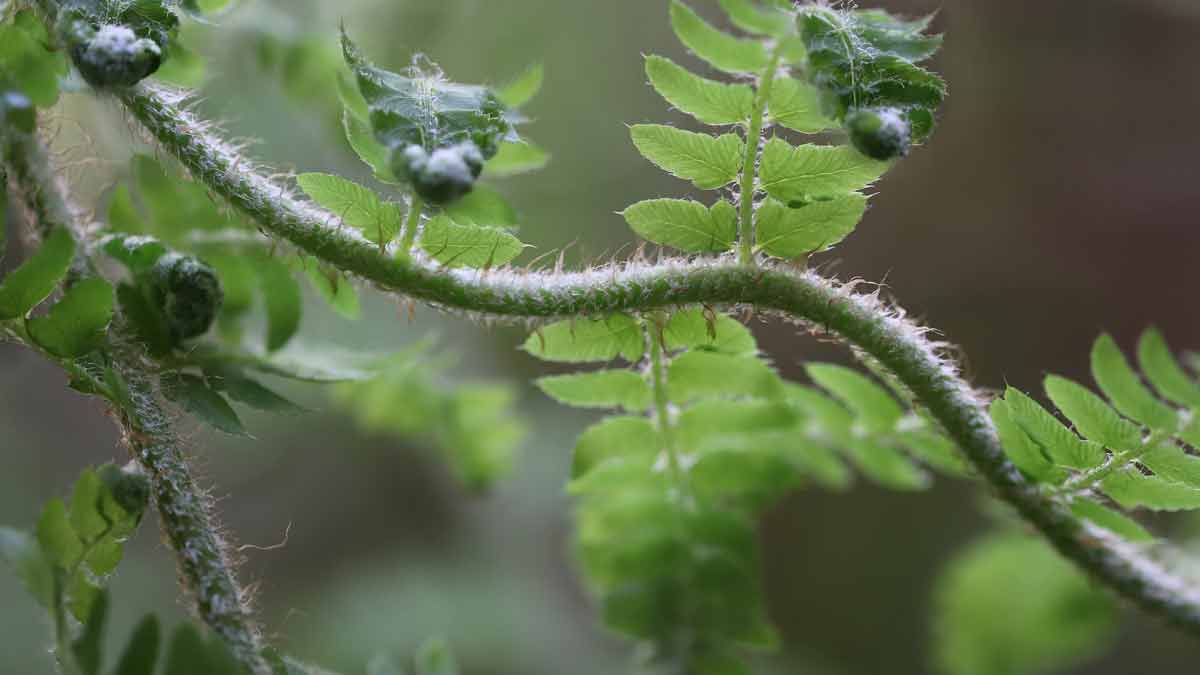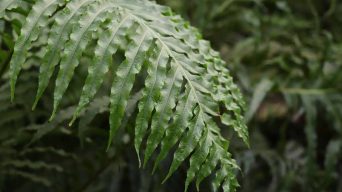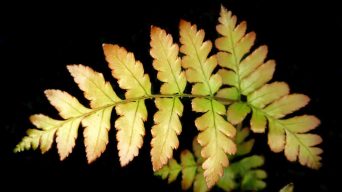Fern leaves can develop white spots caused by powdery mildew or mealybugs. Powdery mildew may also disfigure buds, leaves, and tips. Control measures include removing infected parts, increasing air circulation, and using fungicides. Insecticides or wiping with a damp cloth can treat mealybug infestations.
Ferns are beloved for their lush green foliage, adding a touch of elegance and tranquility to any indoor or outdoor space.
However, fern enthusiasts may occasionally face the common problem of white spots appearing on their plant’s leaves.
Various factors, including fungal infections, bacterial blight, pest infestations, and environmental stressors like direct sunlight or water issues, can cause these unsightly blemishes.
The good news is that you can effectively combat these challenges with proper care and prevention techniques.
Causes Of White Spots On Fern Leaves
Delicate fern leaves can be a sight, but unsightly white spots can mar their beauty.
These spots may appear for various reasons, from menacing fungal infections and bacterial blight to persistent pest infestations and environmental stressors like intense sunlight or water deprivation.
In this complex ecosystem, identifying the root cause of the blemish is crucial for restoring your fern to its full splendor.
Fungal Infections
One of the most common causes of white spots on fern leaves is fungal infections, particularly powdery mildew.
Powdery mildew, a fungus that thrives in warm and humid environments, appears as tiny white or grayish spots on the upper sides of leaves and new growth.
Preventing fungal infections like powdery mildew from harming your beloved ferns requires proactive maintenance measures.
Ensure good air circulation around your plants by providing adequate spacing between them; this can help deter fungi from thriving due to reduced humidity levels.
Additionally, implementing proper watering practices – such as watering at the soil level rather than from above – will minimize lingering moisture on fern leaves that might otherwise invite such pathogens into your indoor garden oasis.
Bacterial Blight
Bacterial blight is a prevalent issue many plant owners face, often leaving them puzzled about the appearance of translucent white spots on their fern leaves.
The primary cause of this condition is a bacterial infection that usually enters the foliage through wounds or abrasions in the leaves.
Plant owners should pay close attention to changes in their fern’s health, as bacterial blight can have detrimental effects if left untreated.
One example involves the progression of small brown fungal leaf spots with yellowish margins developing around these infested areas.
To maintain healthy plants and prevent further damage, it’s essential to address these issues promptly by employing organic fungicides and insecticides like neem oil or horticultural oil and maintaining proper care practices.
Pest Infestations
Pest infestations are another common cause of white spots on fern leaves.
These unwelcome intruders can be hard to detect and devastating to your plant’s health.
Some frequent culprits include mealybugs, scale insects, whiteflies, and spider mites.
For instance, mealybugs appear as small, flat, oval-shaped spots with a fuzzy or powdery texture.
Treating pest infestations promptly is crucial for maintaining healthy plants.
Various treatments are available depending on the type of pest you’re dealing with, such as insecticides or organic options like neem oil and insecticidal soap.
Additionally, introducing natural predators like parasitoid wasps in community gardens can help control pests effectively without causing harm to other organisms in the environment.
Exposure To Direct Sunlight Or Water Stress
Ferns are known for their love of moisture and shade, but too much of either can also spell trouble.
Exposure to direct sunlight or water stress commonly causes white spots on fern leaves.
Direct sunlight can lead to sunburn, which appears as brown or yellow-white spots on the fronds.
To prevent these problems from occurring, make sure your fern is in a location that gets filtered light and not direct sunlight. Water it regularly but be careful not to overwater – check the top inch of soil for dryness before deciding whether to water again.
You can occasionally mist your plant’s leaves with room-temperature distilled water to increase humidity levels.
Effective Solutions To Combat White Spots On Fern Leaves
Delicate and lush ferns make for stunning indoor plants that bring a touch of nature into any space.
However, white spots on their leaves can quickly take away from their beauty and signal an underlying health issue.
To maintain the vitality of your ferns and prevent further damage, implementing a few key practices, such as careful pruning and organic treatments, can go a long way.
Here explore actionable tips to keep your ferns looking their best.
Remove Infected Leaves And Discard Properly
One of the most effective ways to combat white spots on fern leaves is by properly removing and disposing of infected leaves.
Here are some tips on how to do it:
- Wear gloves and use clean, sharp scissors or pruning shears to remove infected leaves.
- Cut the leaves as close to the base as possible without damaging other healthy fronds.
- Place the infected material into a plastic bag, seal it tightly, and dispose of it in the trash immediately.
- Do not compost infected material since it may contain spores that can spread the disease.
- Wash your hands and tools with soap and water after handling infected plants.
Removing infected leaves promptly prevents the disease from spreading to other parts of your fern or other plants in your garden. Remember to regularly inspect your ferns for any signs of infection so you can take action quickly.
Utilize Organic Fungicides And Insecticides
If you’re dealing with white spots on your fern leaves, organic fungicides, and insecticides can be effective solutions.
Here are some options to consider:
- Horticultural oil: This natural oil helps control pests such as scales, mites, and mealybugs that can cause white spots on fern leaves. It works by suffocating the insects and their eggs and can also help prevent fungal diseases.
- Neem oil: Made from the seeds of the neem tree, this organic pesticide is effective against various pests, including whiteflies, spider mites, and leafhoppers. It also has antifungal properties that can help prevent powdery mildew.
- Insecticidal soap: This all-natural spray kills soft-bodied insects like aphids and mealybugs on contact. It’s safe for use around pets and children but follow the instructions carefully to avoid damaging your plants.
- Milk spray: Believe it or not, milk can be an effective fungicide! Mix one part milk with two parts water and spray it on your fern leaves to help control powdery mildew.
- Essential oils: Certain essential oils like clove, peppermint, and thyme have insecticidal properties that can help control pests on your ferns. Mix a few drops of oil with water in a spray bottle and apply directly to the affected leaves.
Always test any new product or method on a small portion of your plant before applying it more widely.
And as with any pest problem, it’s important to address the underlying cause (such as poor lighting or watering practices) in addition to using organic pesticides for best results.
Improve Air Circulation And Reduce Humidity
Proper air circulation and humidity control are essential to keep ferns healthy and free from white spots.
Crowded plants can inhibit proper airflow, which leads to high humidity levels that promote fungal growth.
To improve air circulation around your ferns, selectively prune overcrowded areas or move them to a more spacious location.
Reducing humidity is critical as it helps prevent powdery mildew and other fungal diseases that cause white spots on plant leaves.
One effective way of doing this is by providing adequate spacing between plants, keeping them away from walls and fences, where the stagnant air increases humidity levels.
Regularly monitor for watering frequency—avoid overwatering as this can lead to excessive moisture in the soil—and misting leaves throughout the day since these actions increase relative humidity around your indoor plant’s environment.
Properly Adjust Lighting And Watering Techniques
The lighting and watering techniques used to care for your fern can greatly impact its health and likelihood of developing white spots.
Firstly, ensure that your fern is placed in a location with indirect or filtered light.
Direct sunlight may cause the leaves to dry out and turn grey, which can lead to white spots over time.
Instead, opt for bottom watering or misting around the base of the plant using tepid water. Keep an eye on soil moisture levels and only water when the top inch of soil feels dry.
This will prevent overwatering or underwatering, both known causes of white spotting on fern leaves as they affect their overall condition.
Maintain Proper Plant Care And Maintenance
To prevent white spots on fern leaves, it’s essential to maintain proper plant care and maintenance.
This means ensuring your fern is watered correctly, receives enough light, and is appropriately fertilized.
Overwatering or underwatering your plants can lead to stress and make them more susceptible to disease.
It’s also important to consider the humidity levels around your ferns.
High humidity levels can foster conditions for fungal growth, while low humidity can cause leaves to dry out and become brittle.
Consider using a humidifier in rooms where conditions tend to be dry or placing a tray of pebbles filled with water under the pot.
Prevention Techniques To Avoid White Spots On Fern Leaves
Amidst the lush greenery of ferns, there’s nothing more unsightly than a smattering of white spots marring their delicate leaves.
To preserve the beauty of these botanical treasures, proactive maintenance is critical.
Regular inspection and cleaning, adequate space, soil, and natural pest deterrents, are essential for healthy ferns.
Coupled with careful monitoring of temperature and humidity levels, implementing these solutions will banish white spots and keep ferns flourishing.
Regular Inspection And Cleaning
Regular inspection and cleaning are essential for preventing the buildup of dust, debris, and potential pest or fungal problems on fern leaves.
Follow these tips to keep your ferns healthy:
- Inspect your plants regularly for signs of pests or diseases. Look at the fronds and undersides of leaves for any unusual spots, holes, or webbing.
- Clean the leaves with a damp cloth or sponge to remove dust and debris that may attract pests. Be gentle when wiping down the leaves to avoid damaging them.
- Trim off any infected or damaged leaves with sharp pruning shears. Dispose of these leaves in a sealed bag or container to prevent the spread of infection.
- Use a sterilized potting mix free from fungus gnats, nematodes, and other soil-borne pests. Avoid using garden soil for indoor plants as it may contain harmful pathogens.
- Avoid overcrowding your ferns by providing enough space between each plant to improve air circulation. This can help reduce humidity levels and prevent fungal infections.
- Consider placing your ferns near an open window or fan to improve airflow around the plants.
Regular cleaning and inspection can go a long way in maintaining your ferns’ health and appearance while preventing potential pest infestations or fungal diseases.
Incorporating these tips into your plant care routine can promote healthy growth and beautiful foliage.
Provide Adequate Space And Proper Soil
Proper spacing and soil are essential in preventing white spots from developing on your fern leaves.
Regarding ferns, air circulation is crucial – overcrowding them can lead to higher humidity levels, encouraging fungi and bacteria growth.
Additionally, providing proper soil conditions is critical for healthy fern growth.
Ferns require well-draining soil that contains organic matter, such as compost or peat moss.
Using heavy clay soils can cause waterlogging and contribute to root rot and fungal issues, which cause white spots on their leaves.
Ensure the top inch of soil dries out between watering sessions to prevent overwatering and give the roots time to breathe.
Use Natural Pest Deterrents
In addition to utilizing fungicides and insecticides, natural pest deterrents can also effectively prevent white spots on fern leaves.
Placing a layer of mulch around the base of the plant can help deter pests such as nematodes that thrive in soil.
Additionally, essential oils such as clove or peppermint oil can create a homemade insect-repellent spray.
Alternatively, introducing parasitoid wasps into your garden can naturally control pesky insects like whiteflies and mealybugs.
Avoid Overcrowding
When it comes to maintaining healthy fern leaves, avoiding overcrowding is crucial.
This means providing adequate space for each plant and ensuring they’re not too close together.
Overcrowding can lead to poor air circulation, which increases the risk of fungal diseases and pest infestations.
To avoid overcrowding your ferns, choose an appropriate container size or planting area that allows enough space for each plant to grow properly.
If you notice your ferns starting to crowd each other out, consider thinning them by removing some plants or replanting them in a larger area.
Monitor And Regulate Temperature And Humidity Levels
It is essential to closely monitor temperature and humidity levels to ensure healthy ferns and prevent white spots on their leaves.
Generally, ferns thrive in temperatures ranging from 60-75°F with humidity between 40-60%.
To regulate temperature levels indoors, avoid placing your fern in areas that receive direct sunlight or drafts from heating or cooling sources.
Additionally, watering your plant regularly and providing adequate drainage to prevent soil saturation and root rot is essential.
To create an ideal environment for your fern’s growth and health, a small humidifier can be placed near the plant to maintain proper moisture levels during dry weather conditions.
Final Thoughts
Various factors, including fungal and bacterial infections, pest infestations, exposure to direct sunlight, or water stress, can cause white spots on fern leaves.
It’s crucial to identify the cause of the problem and take practical steps to combat it.
Regular inspection, proper plant care, maintenance, using organic fungicides and insecticides, and improving air circulation are some ways to prevent and treat white spots on fern leaves.
Quick intervention is crucial in controlling diseases like powdery mildew before they spread too far.







